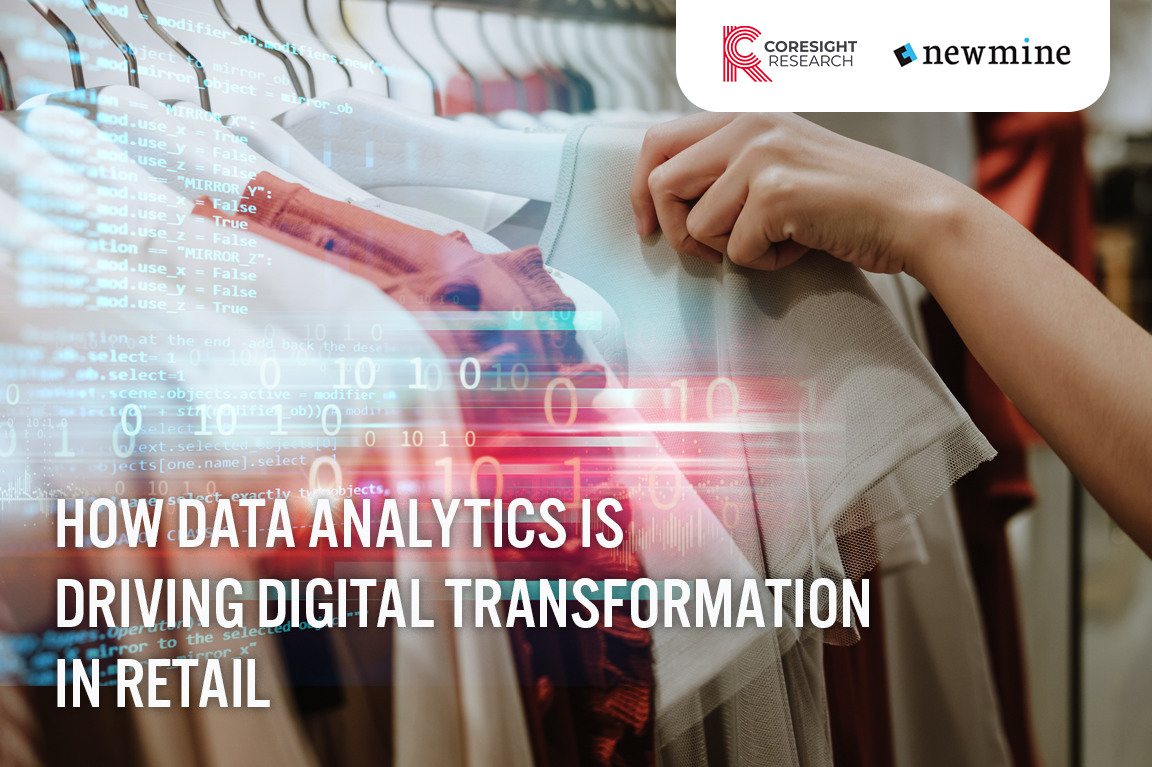
albert Chan
Introduction
Analytics is the collection and analysis of data to inform strategic and operational decision-making. This capability is powering digital transformation in retail, making operations more efficient, from supply chain and store operations to customer service and engagement. Analytics is expected to play an increasingly important role in the sector as the adoption of data-intense technology progresses and requirements increase for tools to leverage larger amounts of data.'
This report—sponsored by retail commerce optimization and returns reduction company Newmine—details how analytics can be applied in the retail industry to transform operational practices, from supply chain and inventory management to customer management and personalization, pricing and promotion strategies and in-store layout management. We will outline the extent to which retailers consider the adoption of data analysis capabilities to be a priority and what factors are encouraging this.
This report also details how analytics is a key component of retailers’ digital transformation through our CORE framework for AI in retail. Finally, we will see how the adoption of data-intense emerging technologies will likely increase the importance of data analytics in retail.
Retail Analytics Informs Strategic Decision-Making
In retail, information on operations, supply chains and consumer and shopper behaviors comprise the raw material for analytics. According to the focus of the analysis and the data collected, we can distinguish between three types of retail analytics:
- Real-time analytics: Monitoring live retail operations to identify possible issues and enable timely deployment of the appropriate response.
- Behavioral analytics: Formulating customer insight based on the interaction shoppers had with the retailer at different touchpoints, including physical and online browsing and purchasing history, as well as interaction on social media.
- Predictive analytics: Intelligence based on data related to historic operational and sales performances and relevant external factors—such as weather conditions, economic indicators and seasonality—to enable reliable and accurate predictions of future demand and inform strategic planning.
These different types may be used for combined applications. For example, behavioral analytics could be used in a predictive manner to anticipate future shoppers’ behavior.
Analytics Applications in Retail
Analytics is useful for multiple applications in retail. Some of the most significant of these are listed below.
[caption id="attachment_98031" align="aligncenter" width="700"]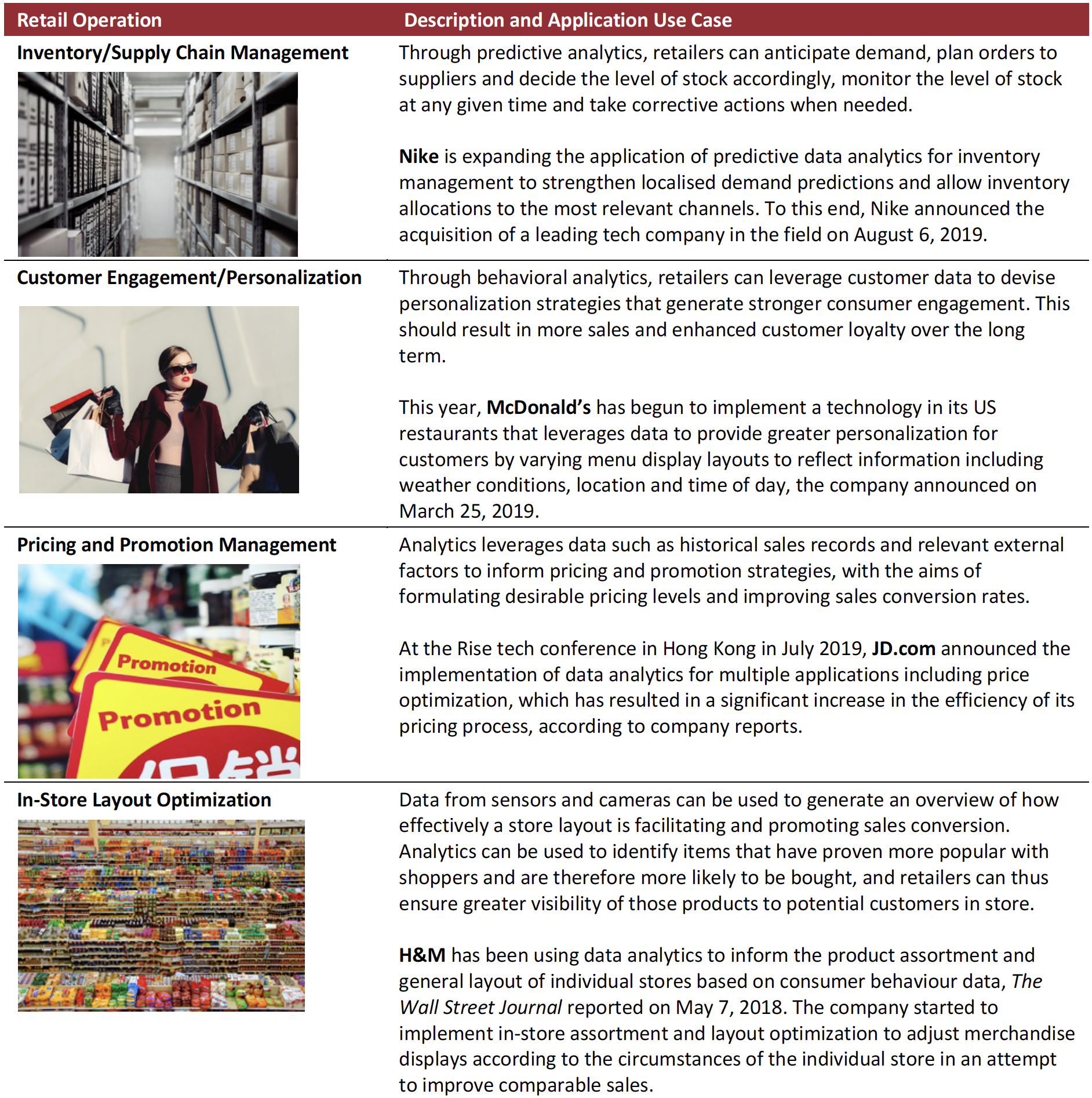 Image source: Unsplash.com
Image source: Unsplash.comSource: Company Reports/The Wall Street Journal/Coresight Research[/caption]
Adoption of an Analytics Capability Is Key for Retailers
The application of analytics in retail aims to provide better understanding of consumer preferences in order to devise a personalized sales approach. This is intended to create a longer-term rapport with customers, increasing conversion rates and consumer loyalty. In addition, retail analytics can bring greater operational efficiency thanks to the increased visibility over operations.
The adoption of analytics capabilities has become crucial for retailers to maintain a competitive advantage in the current market environment and to prepare for future challenges. For example, almost 80% of retailers in Europe have already adopted advanced data analytics capabilities, according to a survey conducted in August 2019 as part of an omnichannel study by Salesforce and Coresight Research. Of these, some 45% fully implemented data analytics across their operations, while 34% had begun to implement the capability in parts of their operations. Only 6% of retailers questioned did not have plans to adopt analytics, according to the survey.
[caption id="attachment_98032" align="aligncenter" width="700"]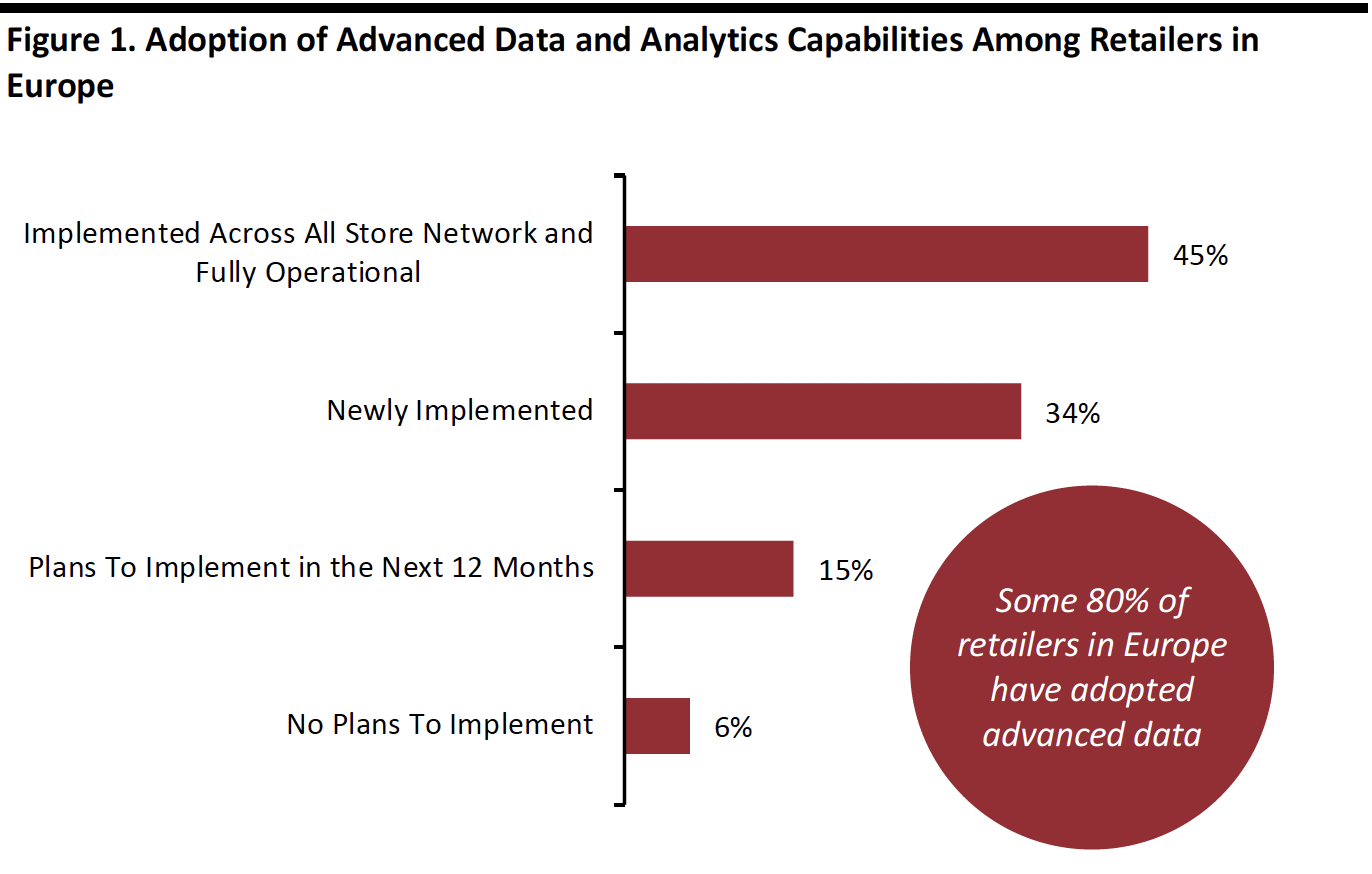 Survey conducted in August 2019 among 470 retail executives based in Europe.
Survey conducted in August 2019 among 470 retail executives based in Europe.Source: Salesforce/Coresight Research[/caption]
Several factors are encouraging retailers to adopt retail analytics, including:
- Large datasets: Data available to retailers has dramatically increased with the widespread adoption of digital technology in retail. Companies now interact with shoppers through multiple touchpoints, and these interactions leave digital footprints of the shopper’s behavior and order history that can be used to feed retail analytics capabilities. In brick-and-mortar stores, the possibility of tracking shopper behavior has been enhanced by the use of sensors and cameras, as well as mobile apps installed on consumers’ smartphones, which all generate data that can be analyzed.
- Advancing technology: The introduction and development of advanced technology such as AI has made it possible to generate actionable insight from the large amount of data currently available to retailers. At the same time, older technologies such as radio-frequency identification have become more affordable and reliable, which means they can be deployed on a large scale across retail operations to collect data that feeds into AI-powered analytics platforms.
- Competitive pressure: The very competitive nature of the retail market encourages companies to adopt analytics strategies in order to achieve competitive gains. Obtaining real-time understanding of operations allows retailers to devise the best course of action to realize operational efficiency, reduce costs and increase profitability, making them more capable of meeting customer needs.
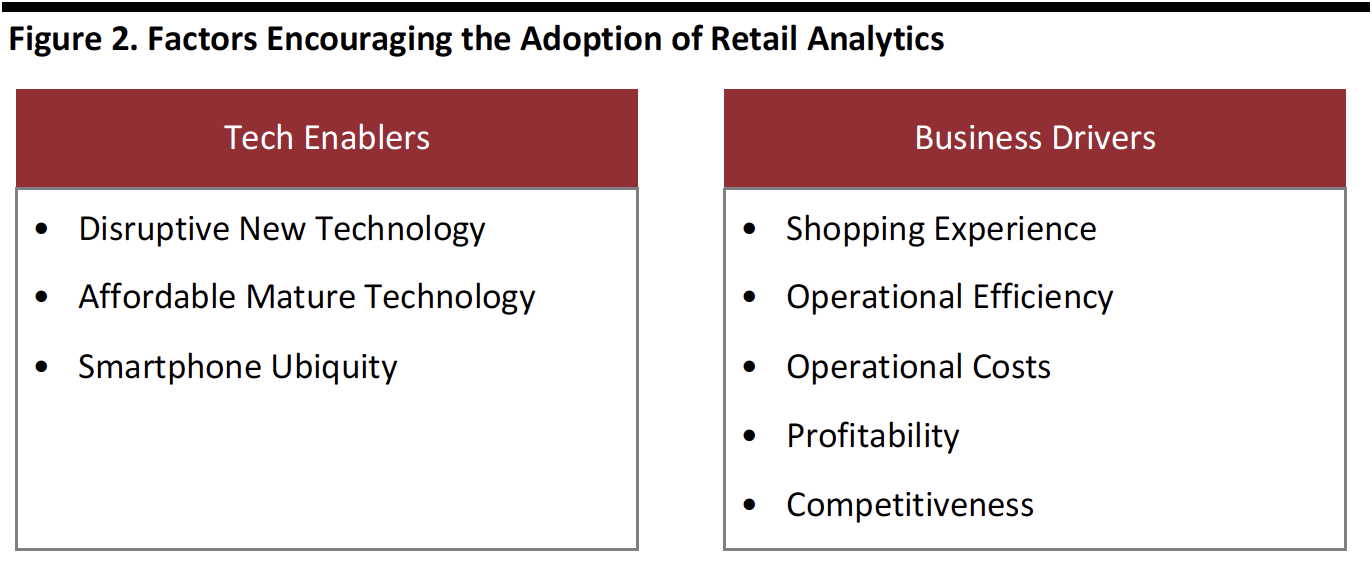 Source: Coresight Research[/caption]
Source: Coresight Research[/caption]
Competition is an important driver for the adoption of analytics capabilities by retailers. To remain competitive and gain a larger market share, companies must equip themselves with the instruments that enable them to compete with best-in-class companies—such as Amazon—that are leading the research and development of analytics technologies. Figure 3 shows the number of patent applications among selected leading retail-related companies in the 12-month period ending September 9, 2019.
[caption id="attachment_98034" align="aligncenter" width="700"] Real-time analytics patent applications and grants by selected major retail-related companies in the 12-month period ended September 9, 2019.
Real-time analytics patent applications and grants by selected major retail-related companies in the 12-month period ended September 9, 2019.Source: Grata Data[/caption]
A Key Component of Digital Transformation
Analytics is a key component of retailers’ digital transformation as it constitutes a fundamental building block of AI, the technology that is radically changing the way retailers operate and interact with shoppers. AI takes retail analytics beyond the analysis of market conditions and consumer behavior to enable computers to formulate autonomous decision-making based on insight from data. Coresight Research’s proprietary CORE framework shows the value of AI in four critical areas of retail competitiveness:
- Communication: AI is key to deliver personalized communication with consumers. Based on the analysis of data related to customer preference records and browsing and shopping history, retailers are able to send more targeted messaging to shoppers.
- Optimize pricing: AI enables the accurate formulation and automation of product pricing decisions, through the analysis of a number of variables: market conditions, sales, promotions, weather and events. Through AI, retailers can identify optimal price points to encourage sales conversions.
- Rationalize inventory: AI optimizes inventory management by monitoring real-time stock levels and informing purchase decisions— predictive analytics can anticipate the likely level of consumer demand based on variables such as external factors, seasonality and sales history.
- Experiential retail: AI enables retailers to refine customer engagement through personalization and improve the shopping experience across multiple channels. Using AI, retailers can bridge the gap between digital platforms and brick-and-mortar stores, creating a more consistent experience for consumers across touchpoints.
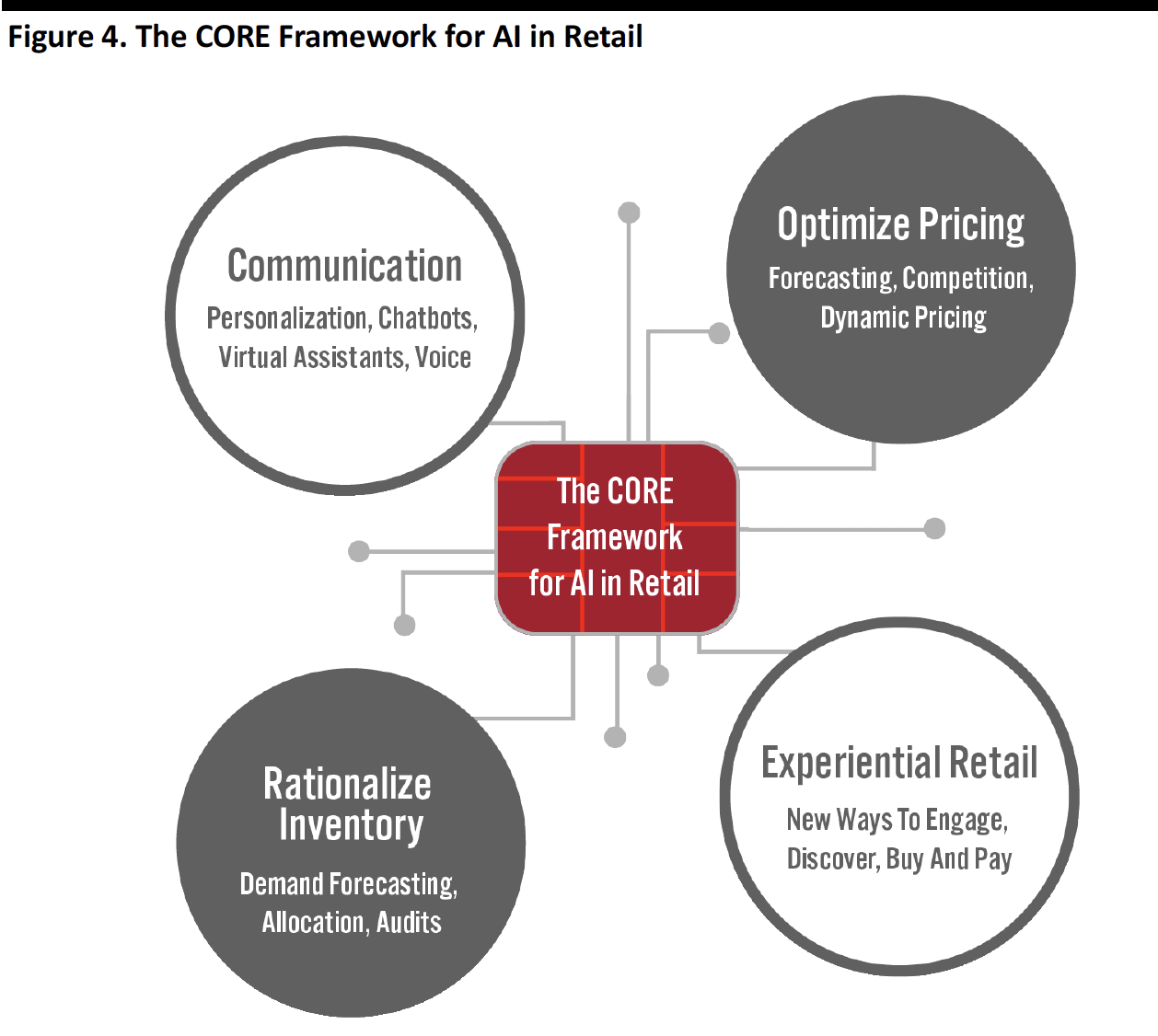 Source: Coresight Research[/caption]
Source: Coresight Research[/caption]
Future of Analytics in Retail: Emerging Technologies To Boost Analytics
We expect retail analytics to play an increasingly important role in the future, in conjunction with the growing adoption of data-intense digital technology by retailers, including AI, IoT and 5G.
- AI: Efficient data analytics platforms will be required to support greater adoption of AI and machine learning in retail. Data analytics feeds AI and machine learning and enables these advanced technologies to gain the insight needed to automate decision-making based on a testing and learning cycle that is conducted autonomously by computers.
- IoT: The growing adoption of IoT systems in retail requires sophisticated retail analytics capabilities to be as effective as possible. The connected devices that comprise IoT systems can collect and share data about their working status with other parts of the network. In the retail sector, key applications for this level of connectivity surround inventory management, logistics, supply chains and in-store operations. The data flow is examined by analytics platforms that then formulate actions for the devices to execute.
- 5G: Stronger data analytics capabilities will be needed to process the large amount of data that 5G connectivity facilitates. In brick-and-mortar stores, 5G offers faster data transmission rates and the possibility of processing more information. As such, it will enable greater adoption of data-rich technology—such as image recognition, computer vision and reality technology—that will detect, react and communicate with shoppers based on their behavior when browsing the store. This will result in more intense in-store shopper engagement and greater customization of the shopping experience.
Key Insights
Retail analytics enables companies to collect and analyze data regarding operations, supply chains and shopper behavior in order to inform strategic and operational decision-making. Three different types of analytics—real-time, behavioral and predictive—can be used to transform retail operations, including inventory and supply chain management, customer engagement, pricing and in-store layout management.
Retailers are increasingly emphasizing the adoption of analytics technologies as a priority. For example, some 80% of retailers in Europe have already adopted advanced data analytics capabilities, according to a recent Coresight Research study. There are a number of factors that are encouraging companies to further leverage analytics: the availability of a large amount of data; the introduction of technology that requires the analysis of large datasets; and competitive pressure in the sector, with major industry players investing extensively in the research and development of analytics technologies.
Retail analytics is a key component of the sector’s digital transformation, as it constitutes the foundation of AI, the technology that enables retailers to enhance communication, adopt price-optimization strategies, rationalize inventory and provide consistent shopping experiences across channels, as laid out in Coresight Research’s CORE framework.
With the growing adoption of data-intense technology—including AI, IoT and 5G—we expect retail analytics to play an increasingly important role for retailers in the future. The implementation of these advancing technologies will require the ability to handle large datasets and continuously upgrade data analytics capabilities.